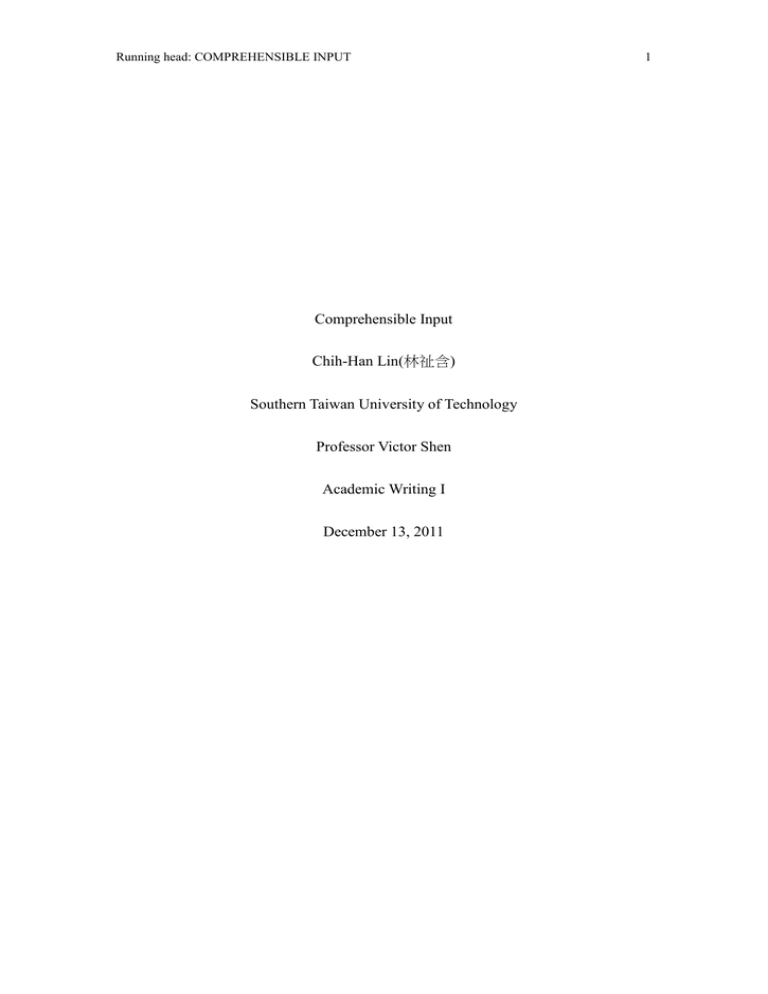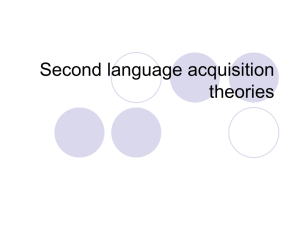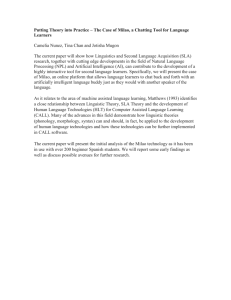Comprehensible Input Chih-Han Lin(林祉含) Southern Taiwan University of Technology
advertisement

Running head: COMPREHENSIBLE INPUT Comprehensible Input Chih-Han Lin(林祉含) Southern Taiwan University of Technology Professor Victor Shen Academic Writing I December 13, 2011 1 COMPREHENSIBLE INPUT 2 Abstract Comprehensible input is important for learners’ language acquisition. Besides, this paper provides information about comprehensible input for educators and students. COMPREHENSIBLE INPUT 3 There are five hypotheses in the monitor theory, including the acquisition-learning hypothesis, the monitor hypothesis, the natural order hypothesis, the input hypothesis, and the affective filter hypothesis (Krashen, 1987). The input hypothesis is defined that when learners understand what they receive, they would acquire language (Cook, 2000). The comprehensible hypothesis had been used by Krashen as the input hypothesis, and it has been a crucial idea in the input hypothesis in recent years. He indicated that comprehension input describe enough than the input hypothesis. The input hypothesis refers that both reading and listening comprehension are crucial for learning language (Krashen, 2002). There are two learning styles in the input hypothesis, including acquisition and learning that develop second language. Acquisition refers that learners are subconscious to get second language by exposing in the natural communicated environment, whereas learning refers that learners are conscious to learn second language (Ellis, 1985). Learner’s learning order is predictable, general, and natural. It defines the order as Natural Order in formulization, such as R1, tR,i, Ri+1, Rn, R1. First language rule is R1. Learner’s present stage is t. Learners just acquire new rule or their present competence is Ri. The next language rule that learner will acquire is Ri+1 (Krashen, 1987). Wu (2010) indicated that the input should be a little beyond learners’ present level of competence that they could progress by understanding the COMPREHENSIBLE INPUT 4 input. Learners develop language naturally. When learners understand the language input, acquisition could occur. Learners present level is a little beyond the language materials is called comprehensible input. Too hard or too easy to understand could not cause input. If the materials focus on what learners have learnt, acquisition is not significant; if the material is highly beyond learners’ present level, the acquisition could not occur. According to Yang (2011), no matter how quantities of input learners learn in second language environment or in the native environment is available to them. Learners could express their opinions by learning language and improving their language ability. When learners have more comprehensible input, they have more second language proficiency. On the other hand, when language learners lack comprehensible input, their language acquisition would be impeded. To sum up, to have more comprehensible input and to give a little higher content to learners could help learners learn second language well. In other words, if educators give too much information that learners do not comprehend, learners could not be proficient in learning a second language. COMPREHENSIBLE INPUT 5 REFERENCES Cook, V. (2000). Linguistics and second language acquisition. Beijing: Foreign Language Teaching and Research Press. Ellis, R. (1985). Understanding Second Language Acquisition. Oxford: Oxford University Press. Krashen, S. D. (1987). Principles and practice in second language acquisition. Oxford: Pergamum Press. Krashen, S. D. (2002). Exploration in language acquisition and use: The Taipei lectures. Taipei, Taiwan: Crane. Wu, W. (2010). The application of input hypothesis to the teaching of listening and speaking of college English. Asian Social Science, 6(9), 137-141. Yang, F. (2011). A study on the application of input theory to reading instruction in vocational college. Theory and Practice in Language Studies, 1(7), 903-905.

